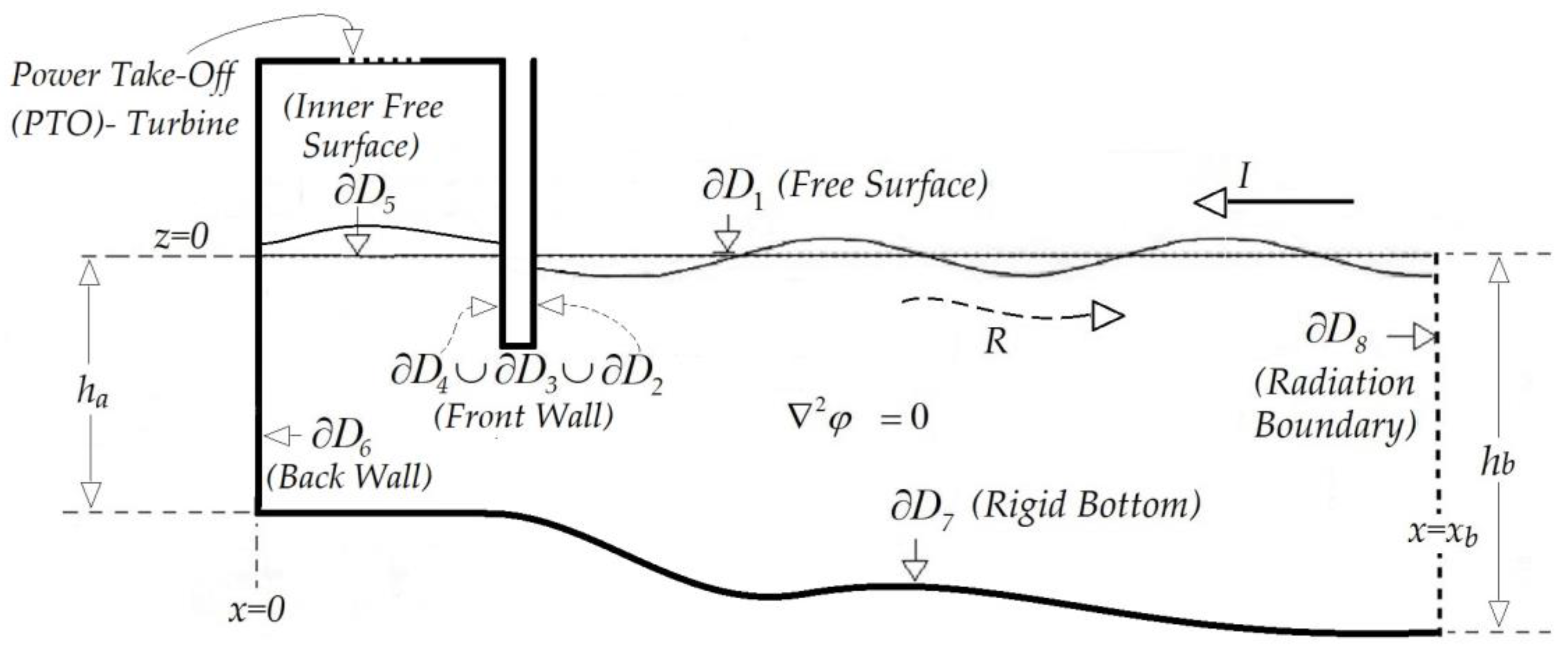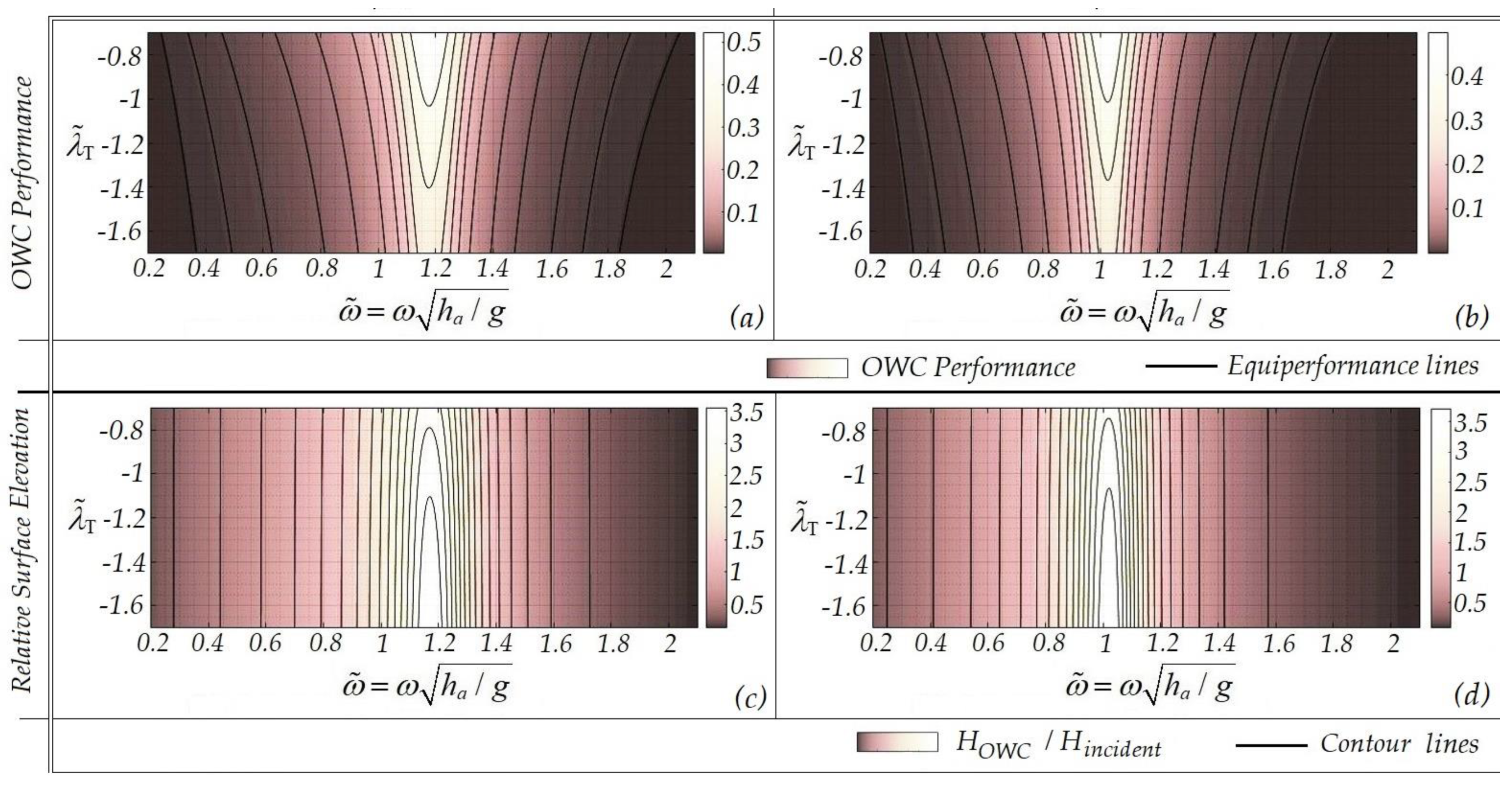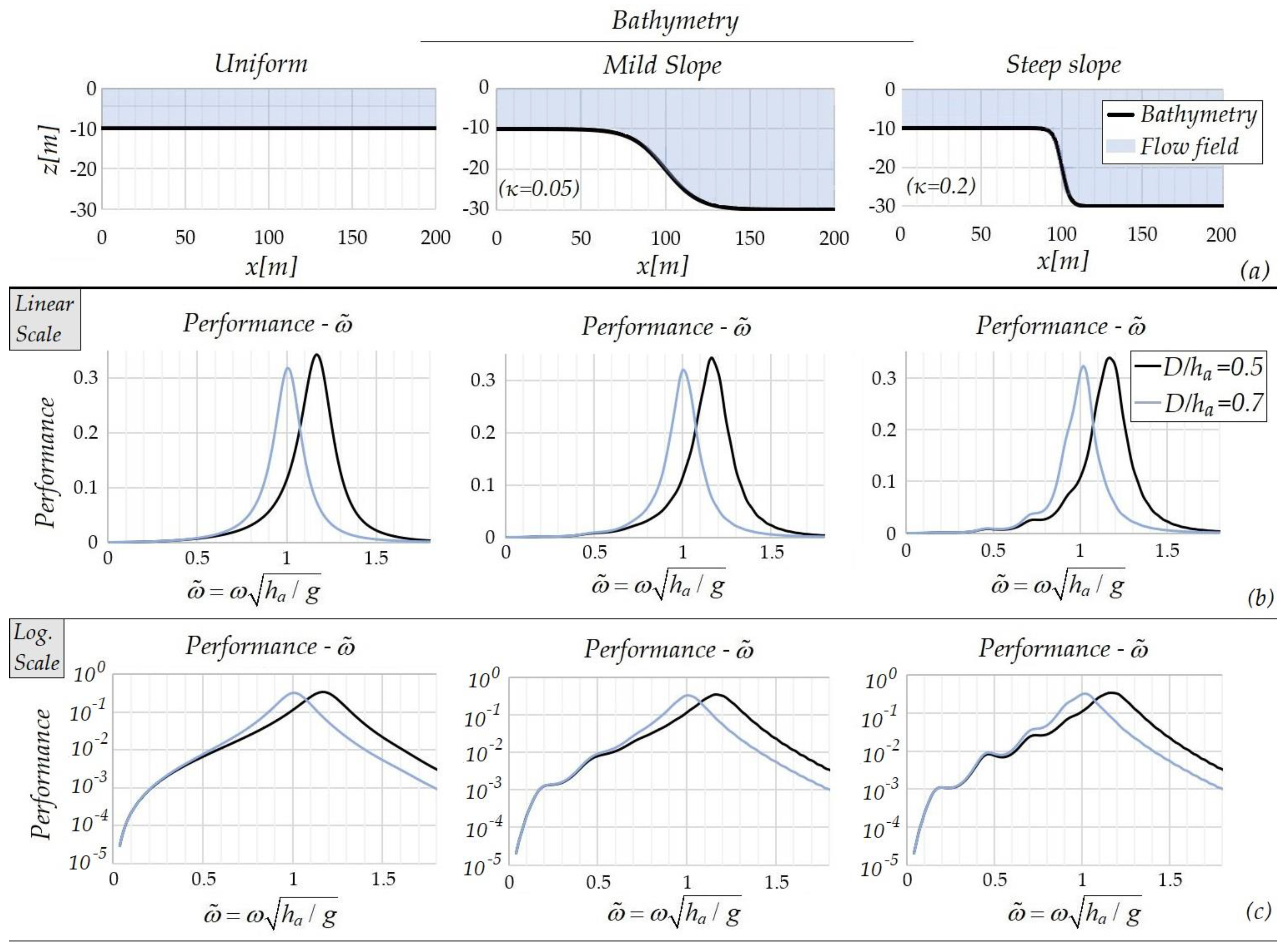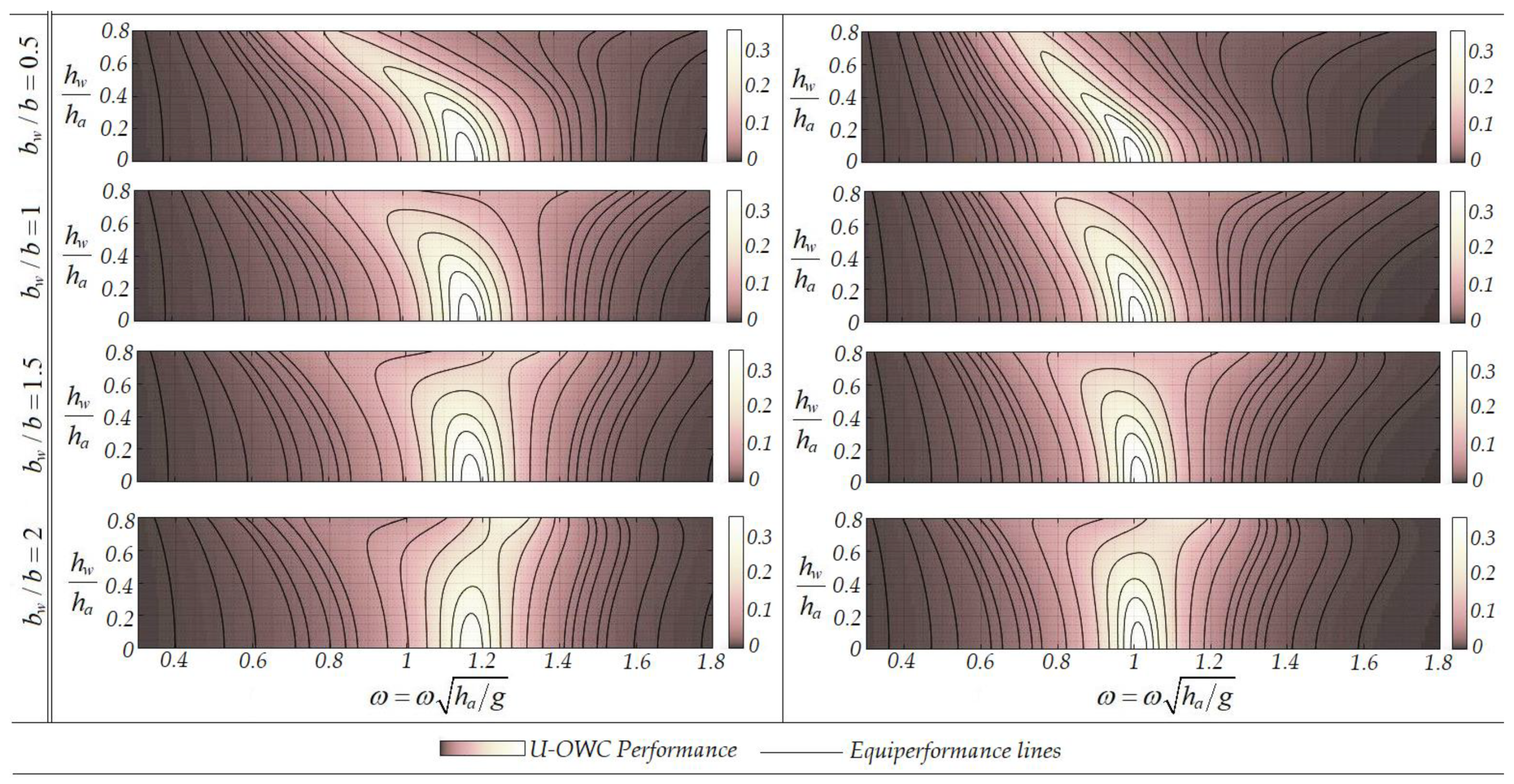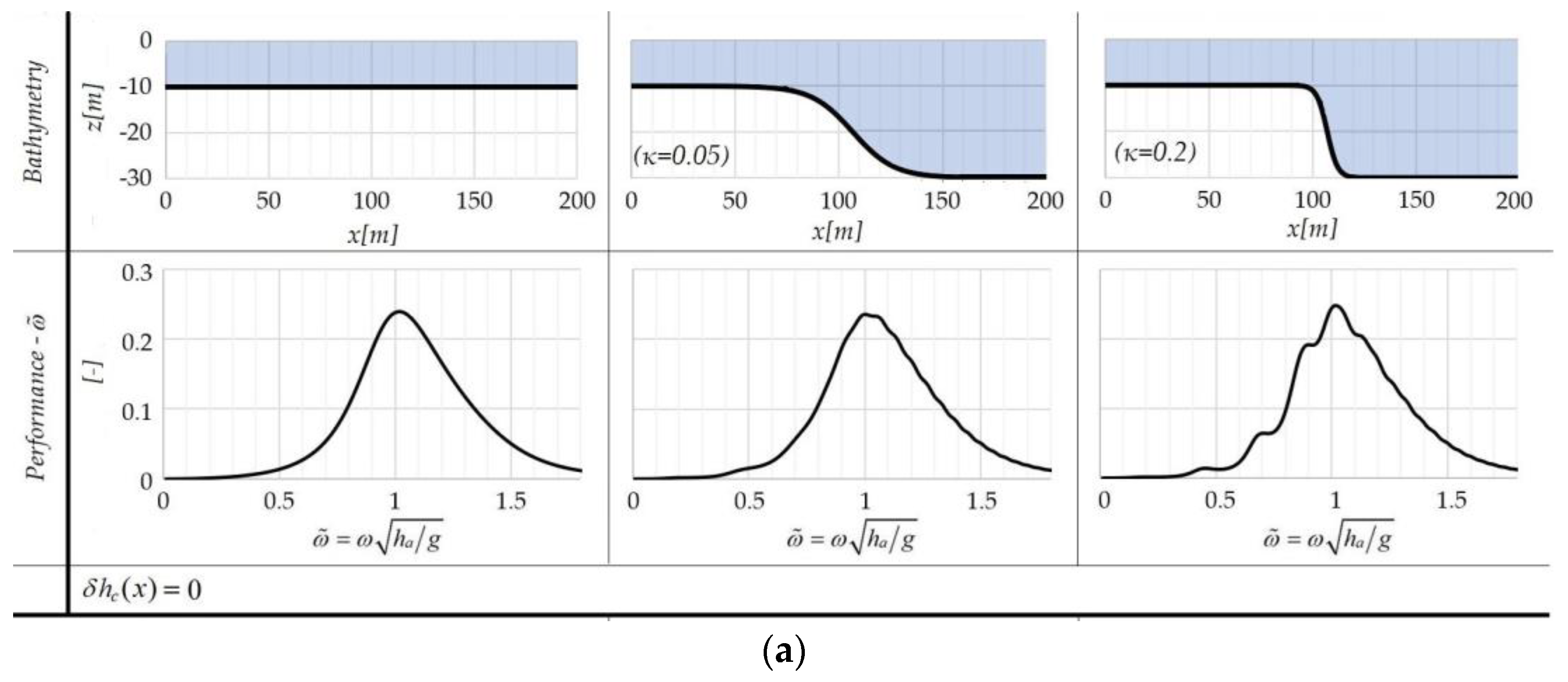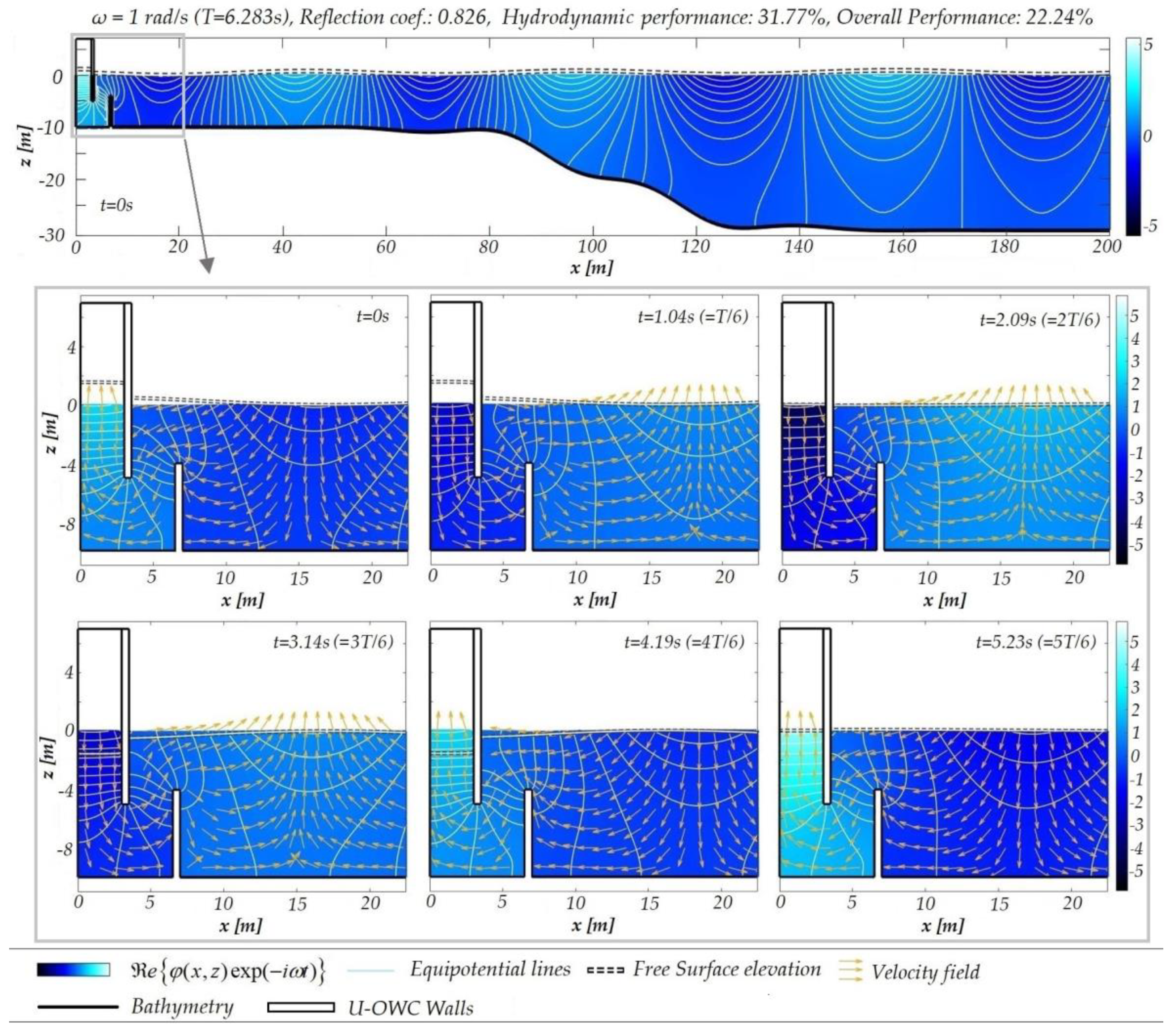1. Introduction
The extensive use of fossil fuels by modern civilization has led to disruptions of the planet’s natural circles via the accumulation of greenhouse gases in the atmosphere. The pressure for more regulations regarding the emissions is intense. Climate change and global warming concerns, in conjunction with the continuing fall in the costs of certain renewable energy equipment, such as wind turbines and solar panels, are driving the increased use of renewables. Wave energy is one of the renewable energy forms that has not yet developed to such an extent as a result of a combination of factors, such as the associated economic risks as well as technical barriers like the energy-capturing devices’ survivability, accessibility, and maintenance. The Oscillating Water Column (OWC) is one of the wave-energy-converting concepts that has been extensively studied in real conditions via prototype devices—see, e.g., [
1,
2]. This has led the OWC to relative commercial maturity.
An OWC system is essentially a chamber, which is a fixed structure with its lower part open to the sea water. The water’s free surface motion inside the chamber, due to wave propagation, alternatively compresses and decompresses the air that is trapped above the water level inside the chamber. The fluid’s movement forces the column to act like a piston, resulting in the generation of an alternating stream of air which is then channeled through a Power-Take-Off (PTO) System. The PTO must be able to convert the bidirectional airflow into beneficial work, which is usually achieved by means of bidirectional turbines. Although floating OWC plants are being studied as well, fixed structure OWCs are, by nature, shoreline devices and thus operate in shallow water regions. As a result, the effects caused to their response due to the presence of bathymetric inhomogeneities could be significant and need to be accounted for. This has been illustrated in the case of WEC point absorbers—e.g., [
3,
4]—as well as surge-type devices [
5] operating in variable bathymetry regions, for which Boundary Element Method (BEM) models have been developed; it is shown that the bottom slope and curvature could alter the performance curves of the systems, especially in shallow water conditions.
In the present work, a novel BEM is developed and applied to the investigation of the performance of the Oscillating Water Column, taking into account the interaction of the incident wave field with the variable seabed topography in the upwave region. For simplicity, we restrict ourselves to the study of two-dimensional configurations and normally incident waves in the context of linear theory. From this perspective, the next section (
Section 2) presents a BEM for a coupled hydrodynamic-thermodynamic analysis of OWC in variable bathymetry. Besides the general theoretical background associated with the approach considered, this section includes a description of the discrete BEM model, as well as examples of model application in uniform depth regions. Further on, in
Section 3 the effects of the seabed profile inhomogeneities are analyzed and discussed, while in
Section 4 an alternative OWC configuration (U-OWC) is considered. This U-OWC is essentially an OWC which includes an additional vertical U-shaped duct for connecting the water column in the chamber to the open sea. In
Section 5 of this work, a case study is presented regarding the potential installation of the OWC in a selected port site in the Black Sea, characterized by a relatively increased wave energy potential, on the coast of Romania. Using the latter data, power performance measures are derived that can be further exploited for a levelized energy cost analysis. Finally, in the conclusion section, a discussion concerning the validity and shortcomings of the present simplified analysis is included, especially as concerns the three-dimensional and real fluid effects, which will be treated in future work.
Although the present simplified BEM model does not fully treat the three-dimensional effects, as well as non-linearity effects, it still provides useful information, especially as concerns the variable bathymetry effects on the performance of the device. The modelling includes the effect of additional walls and barriers, studied in [
6,
7], which are used in front of the chamber to modify the resonance characteristics of the device and improve its performance; more details concerning the U-OWC device can be found in [
7] and the references cited therein. Numerical results illustrating the effects of depth variation in conjunction with other parameters—such as chamber dimensions as well as parameters associated with the turbine and power take-off system—on the device’s performance are presented and discussed, including directions for further research
3. Effects of the Seabed Profile Inhomogeneities
In this section, the developed model is applied to variable bathymetry regions in order to investigate the effect of the wave field-seabed interaction on the OWC performance. The depth profiles that are used in order to model the shoaling environments are defined by:
which describes a smooth shoal between two subregions of constant but different depth—the region of wave incidence with depth
and the region of the OWC configuration with depth
. The maximum bottom slope is controlled by the parameter
and the difference
. Moreover,
is used to model additional bottom irregularities in the upwave region, such as seabed corrugations.
We consider an OWC operating at a 10 m water depth at the end of a 200 m-long variable bathymetry domain ending at a deeper water subregion of depth
. The configuration dimensions remain the same as in the previous case, for comparison purposes, and the same two values of the front wall’s draft
are considered. Additionally, the chamber’s width is equal to 3 m and the turbine coefficient is selected as
. In the case of a smooth shoal, the considered domain bathymetry is illustrated in
Figure 5a, and the calculated performance curves with respect to the non-dimensional frequency for different values of the bottom slope parameter
are shown in
Figure 5b. In the same figure, the corresponding performance curves resulting from simulating the OWC’s operation in the uniform bathymetry domain are plotted for comparison. The observed oscillations in the numerical results are due to the phase variations of various quantities excited by seabed profile irregularities.
As it becomes clear from
Figure 5, the more abrupt the depth changes, the more intense the influence of the flow field’s interaction with the seabed, leading to effects on the performance of the device. In this case, the overall influence of the bottom topography is not very significant. This is due to the fact that the peak performance occurs for incident waves of non-dimensional frequency
, which corresponds to wavelengths of around 40–50 m for the given water depth of 10 m, while the most significant alterations in the performance curves take place in the bandwidth of non-dimensional frequency below
0.8.
Moreover, it is observed in this case that for high frequencies (higher than the peak performance of the studied system), the influence of the seafloor is negligible. This is due to the fact that the interaction of the above components with the seabottom becomes very small. On the other hand, non-linear wave-seabed and wave-structure interactions could generate additional effects that are not represented in the present linearized model, and future work is planned in this direction.
By using an auxiliary grid spanning the entire two-dimensional domain, the distribution of the complex wave potential across the whole wave field can be obtained by the superposition of the potential induced from each boundary element to each point of the grid.
Figure 6 illustrates the wave field around an OWC that operates in a variable bathymetry region in the case of a smooth shoal of mean slope 20%, with the seabed profile being defined by Equation (33) for
and
. Specifically, the figure represents the wave field at some instant (
t = 0) in the domain, while the enlarged area depicts snapshots of the wave field at time instants evenly spaced within a period T. In the latter case, also the wave velocity field is shown by using arrows. Τhe alteration caused to the wavefield due to the shoaling bottom topography including the reduction in the wavelength (from 43 m to 39 m) over the shallower water region of the domain is observed. Furthermore, it is clearly seen in this figure that the equipotential lines intersect all the solid parts of the boundary perpendicularly, which implies the satisfaction of the Neumann boundary condition.
4. The U-OWC Model
The U-OWC is an alternative OWC configuration proposed by P. Boccotti [
6] in 2003. A U-OWC is essentially an OWC which includes an additional vertical U-shaped duct for connecting the water column in the chamber to the open sea. Although the structural modifications needed—with respect to the conventional OWC plants—are not significant, this configuration allows for designing the natural resonance without the use of phase control devices. During operation, sea waves do not directly propagate below the trapped air mass, but the surface motion in the chamber occurs due to pressure oscillations at the opening of the vertical duct.
The present BEM is easily modified in order to model this type of OWC. For this purpose, the domain boundary is modified by including additional parts modelling the extra walls forming the U-shaped duct. Ιn particular, as shown in
Figure 7, three additional straight boundary segments are added to the
. Due to the presence of the additional sub-boundaries, the seabed is split to two sections. The depth of the domain is considered to be constant from the OWC’s back wall to the horizontal position of the additional vertical duct, as shown in the figure. Τhe variable seabed profile starts from the horizontal position
and is defined as follows:
Considering the U-OWC configuration of
Figure 7, the performance of the device is presented in
Figure 8 for different settings of the additional wall, located at distance
from the pre-existing front wall. In particular, the effects of the front wall draft, the duct section, and the front wall height are considered. Comparing the above results to the ones concerning the simple OWC presented in
Figure 4, it is observed that the above parameters significantly influence the peak performance frequency of the system, which could be found useful for the appropriate selection of the parameters and the design of the device.
The non-dimensional turbine parameter is set to
. In the case of a smooth shoaling topography, the performance of the U-OWC modelled by the present BEM is shown in
Figure 9a comparatively to the case of constant depth h = 10 m shown in the first subplot. The additional effects of bottom corrugations on the calculated performance of the device are presented in
Figure 9b. In this case, the seabed profile is defined by Equation (34) using
and
.
The calculated wave field around the U-OWC considered in the above variable bathymetry region is illustrated in
Figure 10 using equipotential lines. As before, the enlarged area depicts snapshots of the wave field near the OWC at evenly spaced time instants within a period
T. In these plots, the wave velocity is also presented using arrows. In the examined case, for a given angular frequency of 1 rad/s the reflection coefficient is calculated 0.826 and the device’s performance is 22.2%. A stronger interaction of the wavefield with the seabed can be observed as well as the relative reduction of around 16% in the wavelength over the shallow region (from 61.3 m to 59.6 m). For the same case and the same values of wave frequency and parameters, it is noted that the device performance in the absence of the vertical duct, as calculated by the present model, is about 16%, indicating a significant increase in performance obtained by the U-OWC.
5. Application to a Coastal Site in Mangalia Port
In several works, the incorporation of OWCs into existing harbour infrastructure is proposed in order to maximise the cost-effectiveness; see, e.g., [
11,
12]. In this context, during the last decade different plants were built at full scale to convert wave energy into electrical power. Unlike offshore wave-capturing devices, coastal ones—like fixed structure OWCs—greatly facilitate installation and maintenance procedures, while they eliminate the need for deep-water moorings and long submerged electrical cables for transporting the electricity produced. In this context, the potential installation of OWC into pre-existing infrastructure at the port of Mangalia in the southern part of the Romanian coast is examined in this section. In more detail, a 300 m-long array of OWCs arranged at the northern breakwater of the port is considered, as illustrated in
Figure 11.
In the considered area, the wave conditions are calculated in previous studies using the multilevel wave modelling system SWAN (Simulating WAves Nearshore) [
13]. SWAN is a third-generation numerical wave model based on the spectrum concept that integrates the action balance equation in time in the geographical and spectral space, which are defined by the relative frequency and the wave direction [
13]. The latter has been implemented and extensively validated in the Black Sea. The wind fields at a 10m height over the sea level (U10) provided by NCEP-CFSR [
14] have been considered for forcing the system at the sea level.
This field has a spatial resolution of 0.312o × 0.312o and a temporal resolution of 3 h. At this point, it has to be highlighted that the wind data accuracy and resolution is a fundamental issue in reflecting the wind variability of such complicate marine environment as the Black Sea and represents also the most significant aspect in obtaining credible wave predictions in the modelling process.
The reliability of the SWAN-based wave prediction system in the above region implemented at the sea level is discussed in [
15], where some data assimilation methods have been also developed in order to improve the accuracy of the results. A comparison against satellite data shows in general good results, especially considering the relatively complicated marine environment targeted. Further results of this wave modelling system at the sea level are also presented in [
16], where the wave and wind energy are evaluated in the coastal environment of the Black Sea. A second computational level focused on the western side of the Black Sea was defined in [
17]. Further on, several areas with increased resolution in the geographical space have been implemented and validated against in situ measurements and remotely sensed data [
18]. From this perspective, in the present work a three-level wave prediction system has been considered and used for providing wave predictions in the vicinity of the Mangalia harbour, located in the southern part of the Romanian nearshore. The geographical space and subregions considered are illustrated in
Figure 12 and the characteristics of the corresponding computational grids defined are presented in
Table 1, while the physical processes activated in the simulations with the SWAN model corresponding to these three computational levels considered are presented in
Table 2. Although the bathymetry at level 3 (see
Figure 12) is relatively mild and does not necessarily lead to the excitation of strong diffraction phenomena (for water depths above 10 m), the abrupt variation in depth near the coastline could generate local diffraction/reflection phenomena, and for this purpose SWAN level 3 with diffraction activated has been used in the simulations.
More specifically, in
Table 2 Wave indicates the wave forcing, Tide indicates the tide forcing, Wind indicates the wind forcing, Curr indicates the current field input, Gen indicates generation by wind, Wcap indicates the whitecapping process, Quad indicates the quadruplet nonlinear interactions, Triad indicates the triad nonlinear interactions, Diff indicates the diffraction process, Bfric indicates the bottom friction, Set up indicates the wave-induced set up, and Br depth indicates induced wave breaking. With this three-level SWAN-based modelling system, simulations have been performed in the present work for the 10-year period 2007–2016 and the results in a target point TP with the coordinates (28.68° E, 43.83° N) are further considered. Further information concerning the nearshore wave dynamics at Mangalia beach simulated by spectral models are provided in [
19]. The calculated nearshore wave climatology is presented in
Figure 13, and details concerning the analytical probability models used for univariate and multivariate data can be found in [
20,
21].
Given that the model developed and presented in this work is limited to a two-dimensional analogue of OWC devices, it is considered that the wave power flux received by the considered configuration is identical to that of the TP region, provided that the propagation direction is limited within the range . For propagation directions outside this range, no power flux is considered to be received by the array.
The corresponding polar histogram as well as the monthly mean values of the wave power flux per meter of wave front after the aforementioned limitation are presented in
Figure 14.
The mean value of the energy period occurring at the specific geographical area equals 2.86 s (see
Figure 13a). However, these sea states are associated with relatively low wave heights due to the correlation between the two variables (see
Figure 13b).
On the other hand, the occurrence of waves characterized by increased energy periods (e.g., Τ > 8 s) is very scarse in the specific site. A normalized distribution of the available wave energy with respect to the incident energy period associated with the population of waves in the nearshore/coastal area examined is presented in
Figure 15, as obtained from the climatological data of
Figure 13 (after applying the direction limitation). It can be clearly seen that the wave period with the highest energy content significantly differs from the mean value and is around 4.3 s. The latter provides useful information regarding the dimensioning of the considered devices.
The water depth at the northern breakwater of the port is 15 m. Therefore, the non-dimensional frequency corresponding to the highest-energy-content energy period equals
. We consider conventional OWC devices with 2.5 m-wide chambers (b = 2.5 m). The front wall’s thickness is set to d = 0.5 m, while the Wells turbine non-dimensional parameter is set to
, so that the peak performance achieved by the configuration remains unchanged relative to the previously discussed examples of 200 m-long configurations, taking into account the considered chamber’s reduced width and the length of 300 m in the transverse dimension (Equation (23)). The front wall’s draft as well as the chamber’s height were selected so that they are both greater than the maximum wave amplitude (H/2) encountered in the hindcast data, corresponding to an incident wave period of
for each configuration’s eigenperiod, multiplied by a factor of 3 (see
Figure 4). After the relevant calculations, it was found that a close-to-optimal selection, (assuming that
), is
, which, in conjunction with the rest of the parameters, results in peak performance at
(Further reduction in the eigenperiod, for the given chamber’s width, requires reducing
and
, which would result in the aforementioned criterion being unsatisfied based on the climate data of
Figure 14.)
The latter results were obtained via the developed BEM model for water of constant depth equal to 15 m. However, given the depth of the installation location and the eigenfrequency of the selected configuration, changes in the depth profile introduce negligible changes in the performance curve, as depicted in
Figure 16. The device’s operation was simulated at an indicative 1 km-long domain, with the water depth varying from 25 m at the incidence-radiation boundary, to 15 m at the region of the OWC located at the northern breakwater of Mangalia port.
The resulting mean monthly values of power output, expressed in [kW/m], are presented in
Figure 17. The overall mean value of wave power output equals 0.135 kW/m. Given that the results were extracted via a two-dimensional analogue, the power output in [kW] can be estimated by multiplying the power output per meter of wavefront by the considered array’s width, which is considered to be 300 m. (Apparently, this estimation neglects all the effects caused due to the three-dimensional nature of the considered configuration). Eventually, the annual energy production (AEP) can be estimated in [kWh] by multiplying the overall mean value of power output in [kW] by the total number of hours within a year (8766):
By artificially shifting the performance curve of the system (see
Figure 16b) towards the optimal operating point, it can be found that the achieved power output per meter of wavefront reaches 0.1534 KW/m (for the shifted curve), for peak performance at
, which matches the expected result based on the Normalized Power flux curve of
Figure 15. The shift in the system’s eigenperiod can be achieved—apart from reducing the previously discussed dimensions
and
—also by reducing the chamber’s width, b. The AEP in this case increases to
.
Although the results from the present study show that the expected electric power in the target area is not very high, some recent works [
22,
23] indicate that there is significant wind power potential in this coastal region, and furthermore that there are also expectations of an enhancement of the average wind power in this area [
24]. From this perspective, it would make sense for hybrid wind-wave energy farms to be implemented in this nearshore and the present study provides relevant information also in this direction.
To conclude, it should be noticed that the results presented and discussed in the present work are based on a linearized model, based on small-amplitude wave theory and are considered as preliminary estimates providing useful information for the design of OWCs including the effects of seabed variation in the upwave subregion of the device. However, the operation of OWCs is also dependent on several non-linear effects, such as the ones associated with the chamber thermodynamics; the turbine characteristics; and the fluid-structure interaction, including wave breaking—e.g., [
25,
26,
27]—which are left to be considered in future work.
